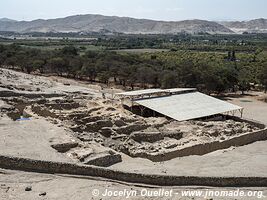Pacific Coast - part 3
Back on the coast after a few weeks in the mountains.
Ruins of Cerro Sechín
The archeological site of Cerro Sechín dates from 1600 BC, and was discovered in 1937.
The main characteristic of the site is the facade decorated with bas-reliefs. The 300 or so reliefs represent priest warriors or mutilated body parts. The priest warriors are holding a weapon or a sceptre.
Road from Casma to Lima - part 1
Fortaleza de Paramonga
Paramonga is a fortress built entirely of adobe bricks and it belongs to the Chimú culture. The structure was erected around AD 1000 with a defensive purpose. After the conquest of the Inca, the site was used as a worship centre.
Nowadays, the structure, with a height of nearly 30 metres, towers above the surrounding plains. The main agricultural crop in the regions is sugar cane.
Road from Casma to Lima - part 2
Lima
Lima, the capital of Peru, is a megalopolis of about 10 million inhabitants. According to some guidebooks, the city has a nice colonial architecture in addition to a substantial collection of museums, art galleries, and restaurants. Despite all those attractions, I didn't really like this city.
It is true that it has some interesting attractions, but I have not been impressed by any of them. I stayed there for one week, and I have been greeted by a week of gloomy weather. It didn't help in my appreciation of the city.





































































